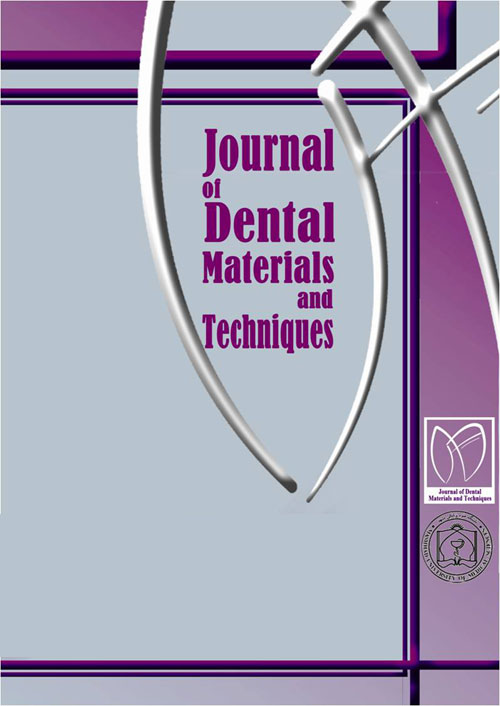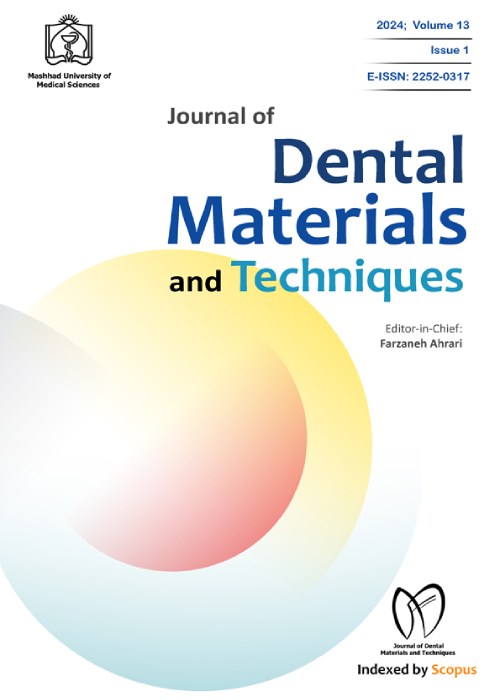فهرست مطالب

Journal of Dental Materials and Techniques
Volume:4 Issue: 2, Spring 2015
- تاریخ انتشار: 1394/01/18
- تعداد عناوین: 8
-
-
Pages 57-64IntroductionThe aim of the present study was to evaluate the effect of glass ceramic insert in the sandwich technique to reduce microleakage in class II composite resin restorations.MethodsSixty sound human upper second premolars were selected and randomly divided into six groups (n=10). Class II box-only cavities were prepared in distal aspects of each tooth with gingival margin located approximately 0.5 mm below the CEJ. Group A (Control) was restored incrementally with Tetric Ceram and a total-etch bonding technique. Group B and C were restored with sandwich technique using a compomer (Compoglass F) or flowable composite resin (Tetric Flow) as the lining material at gingival floor, respectively. Group D, E and F were represented in the same way as group A, B and C and a glass ceramic insert was added to the composite bulk. The specimens were thermo-mechanically cycled, and then immersed in 0.5 % basic fuschin for 24 hours. Dye penetration was detected using a sectioning technique.ResultsNo significant difference was found between total-etch bonding and sandwich techniques. The placement of an insert caused an increase in microleakage in all groups significantly (P < 0.05). Group D (no liner/ with glass insert) showed the highest amount of microleakage and Group A (no liner/ without glass insert) resulted in the lowest amount of total microleakage.ConclusionPlacement of glass ceramic insert could not decrease gingival leakage. According to the limitation of this study a composite resin restorations with incremental technique is recommended.Keywords: Microleakage, Posterior composite resin restoration, Sandwich technique, glass ceramic insert
-
Pages 65-72IntroductionThe aim of this study was to compare digital and conventional radiography in determining the working length of dilacerated canals.MethodsThirty nine human extracted single-rooted teeth with root curvature more than 35 degrees were included in this study. After access preparation, a file was inserted into the canal and advanced until the file tip was visualized at the foramen. With measurement of the file length using a millimeter ruler, true canal length was determined for each canal. Then, teeth were mounted in acrylic blocks and canal length was estimated by using on-screen digital radiography with both 3- and 6-clicks measurement and from conventional radiography by conforming a preserved file on the image of the root canal.ResultsThere were no significant differences in measurement accuracy between the true canal length and conventional radiographic length, but there were significant difference between both digital radiographic techniques with true canal length. There was no significant correlation between root curvature and canal length estimation error of studied methods.ConclusionIn dilacerated canals, the accuracy of determination of working length by using conventional radiography is higher than digital radiography.Keywords: Digital radiography, conventional radiography, working length, root curvature, dilaceration
-
Pages 73-80IntroductionThe purpose of this study was to evaluate the sealing ability of dentin bonding agents in root canals obturated with gutta-percha and MTA.MethodsForty-five single rooted human premolar teeth were decoronated so that remaining root portions were 12 mm in length. The samples were divided randomly into three experimental (n=13) and two control groups (n=3). All teeth were instrumented up to #40 K-file using step-back technique. The roots were obturated with gutta-percha/AH26 and MTA for 5 and 3 mm, respectively. Excite, Clearfil SE Bond, and iBond were applied for experimental groups and then 2mm was filled with composite Filtek Z250. The roots in the controls were merely instrumented and obturated. Two coats of nail varnish were applied on the surface of the teeth in the experimental and positive groups, except 2 mm around the apical foramen and coronal surfaces. In the negative control, the surfaces were completely covered by two layers of nail varnish. After thermocycling, the roots mounted in plastic caps of tubes containing BHI medium and inoculated coronally with Enterococcus faecalis. The data were statistically analyzed using Fisher''s exact and Kaplan-Meier survival Analysis.ResultsThere were no statistically significant differences between three experimental groups regarding the leakage rate (P=0.738).ConclusionWithin the limitations of this study, it was observed that the adhesive systems in alliance with gutta-percha and MTA obturation could not entirely prevent bacterical leakage, and their sealing abilities were not statistically different.Keywords: Bacterial leakage, adhesives, Enterococcus faecalis
-
Pages 81-88IntroductionComparison of the relationships and distance between maxillary root tips and the maxillary sinus floor using oral panoramic in the dolichocephalic and brachycephalic compared to mesocephalic individuals.MethodsOral panoramic images from 300 individuals were analyzed and the relationships and distance between the maxillary root tips and the sinus floor was assessed by qualitative and quantitative variables.ResultsThe distance was significantly higher in the brachycephalic groups than that of the mesocephalic, and the mesocephalic group showed longer distance in comparison to dolichocephalic individuals. Qualitative comparison showed that type 1 relationship was the dominant position in the brachycephalic individuals while most of dolichocephalic individuals demonstrated type 2 and 3 relationships of the molar root tips and the maxillary sinus floor.ConclusionHigher distances between the molar root tips and the maxillary sinus floor could be expected in the brachycephalic than mesocephalic and dolichocephalic individuals.Keywords: Maxillary sinus, Molar teeth, OPG, Maxilla
-
Pages 89-94IntroductionPulpectomy is a conservative treatment plan for primary necrotic teeth and Zinc Oxide Eugenol is still a good choice as root canal filling material but long term studies on poor prognosis molars are limited and almost contradictory. The purpose of this study is to evaluate the clinical and radiographical success rate of pulpectomy of necrotic primary molars using ZOE as the root canal filling material.Methods152 records of 76 primary molars on which two-visit pulpectomy had been performed were selected. The records with a complete and enough clinical history and high quality radiographs of before the treatment and follow up sessions were included to the study. The least follow up was 6 months and the most one was 59 months (with the mean follow up of 24 months). The treatments were noted successful if clinically had no signs and symptoms and radiographically, the size of pathologic radiolucencies of before the treatment have been reduced or at least remained without any changes. Then obtained information was analyses in SPSS 17 and by Chi- square and Log Rank tests.ResultsFrom all 76 cases 5 teeth (6.6%) were radiographically failed that all of them were second primary molars and 2 teeth were clinically failed (2.6%) that both were second primary molars.ConclusionTwo-visit pulpectomy of primary molars with ZOE as root canal filling materials is one of the most successful treatments for necrotic teeth.Keywords: Primary molars, Pulpectomy, Zinc Oxide Eugenol
-
Pages 95-100IntroductionThis study was conducted to determine the pattern of maxillofacial fractures in three age groups of adults, adolescents, and children, using CT scan images.MethodsIn this cross-sectional study, CT scan images of 230 patients with maxillofacial trauma during one year were examined in terms of the number and site of fractures. The patients were divided into three age groups, children (0-14 years), adolescents (14-17 years), and adults (>17 years). The data collected from this group were analyzed using, Chi-square, independent t-test and ANOVA statistical tests.ResultsThe analysis showed that 85% of maxillofacial fractures occur in adults, 7% in adolescents, and 8% in children. The most prevalent causes of fractures in adults were accidents (70%) and fallings (16%). Accidents (73%) and quarrels (13%) were the most prevalent causes of fractures in adolescents. In children, falling (60%) as the most prevalent cause of fracture was significantly higher than that in other groups (P-value=0.001). The most prevalent sites of maxillofacial fracture in adults were nasal bones and zygomaticomaxillary complex. Nasal and orbital fractures in adolescents comprised the most prevalent sites of fracture. Mandibular bone was the most prevalent site of fracture in children. The variations in prevalent sites of fracture among the three groups were significant (P-value=0.002).ConclusionCar accidents are the main risk factor for maxillofacial fractures. The prevalent causes and sites of maxillofacial fractures in adults, adolescents, and children are different from one another.Keywords: Fracture, maxillofacial, trauma, adults, adolescents, Children
-
Pages 101-110IntroductionThe aim of this study was to investigate whether there is any relationship between the condition of complete dentures and TMDs.MethodsThe sample consisted of 61 consecutive patients (35 females and 26 males) who were admitted to the Department of Prosthodontics of Mashhad Faculty of Dentistry for fabrication of new complete dentures. The age range of the participants was between 32 and 80 years, with the mean age of 57.05±10.26 years. The patients were examined by two prosthodontists. Using a questionnaire, the first prosthodontist asked the patients about their habits and history of trauma to the temporomandibular joints (TMJs). She then examined the participants for signs and symptoms of temporomandibular disorders (TMDs). The second prosthodontist examined each participant''s existing denture and checked its fit, stability, retention, occlusion, and centric relation, and recorded how long it had been in service. The examination was double blind. The data were recorded in examination sheets.ResultsThe relationship between TMDs and denture fit, stability, retention, centric relation and occlusion was analyzed using Fisher’s Exact Test. No significant relationship was found between denture characteristics and TMDs in complete denture wearers (P-value>0.05).ConclusionComplete denture characteristics did not play a role in the development of TMDs in edentulous patients.Keywords: Complete denture, edentulous patients, temporomandibular disorders
-
Pages 111-114Orthodontic treatment of individuals with metal hypersensitivity is a matter of concern for the orthodontist. Orthodontic appliances contain metals like Nickel, Cobalt and Chromium etc. Metals may cause allergic reactions and are known as allergens. Reaction to these metals is due to biodegradation of metals in the oral cavity. This may lead to the formation of corrosion products and their exposure to the patient. Nickel is the most common metal to cause hypersensitivity reaction. Chromium ranks second among the metals, known to trigger allergic reactions. The adverse biological reactions to these metals may include hypersensitivity, dermatitis and asthma. In addition, a significant carcinogenic and mutagenic potential has been demonstrated. The orthodontist must be familiar with the best possible alternative treatment modalities to provide the safest, most effective care possible in these cases. The present article focuses on the issue of metal hypersensitivity and its management in orthodontic patients.Keywords: Nickel, Titanium alloy, biological effects, biocompatibility, tissue reaction, orthodontics, corrosion


